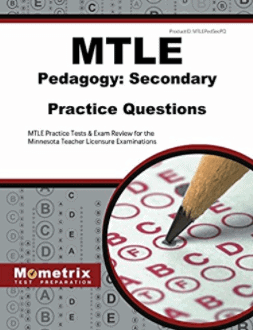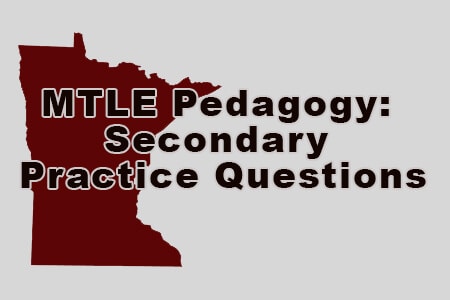If you’re wanting to become a teacher in Minnesota, you will first need to take and pass the MTLE in order to obtain your initial teaching license for the state of Minnesota. Along with the initial MTLE exam, you can also take exams in different content areas as well as Pedagogy exams such as Early Childhood, Elementary, and Secondary.

The MTLE Pedagogy: Secondary exam consists of two subtests. Both subtests contain 50 multiple choice questions and both are timed
for one hour.
The first subtest of the MTLE Pedagogy: Secondary exam consists of:
• Student Development and Learning
• Understand development during the
secondary school years and how to
provide learning opportunities that support students’ physical, social,
emotional, moral, and cognitive development.
• Understand learning processes and how to provide instructional opportunities that promote student learning and achievement.
• Understand student diversity and how to provide instructional opportunities that meet the needs of students with diverse backgrounds and exceptionalities and promote all students’ learning and achievement.
• Learning Environment
• Understand how to establish a safe, inclusive, and positive learning environment that encourages positive social interaction, active engagement in learning, and self-motivation.
• Understand how to create an organized and productive learning environment that promotes all students’ participation and learning.
• Understand how to use effective verbal, nonverbal, and media communication techniques to promote active inquiry, learning, collaboration, and supportive interaction in the classroom.
The second subtest of the MTLE Pedagogy: Secondary exam includes:
• Instruction and Assessment
• Understand various types of assessment; relationships among assessment, instruction, and learning; and the use of assessment to ensure students’ continuous development and achievement of defined standards and goals.
• Understand instructional planning procedures and how to use effective planning to design instruction that promotes learning and achievement for all students.
• Understand how to use a variety of instructional strategies to provide effective and appropriate learning experiences that promote all students’ achievement and foster development of critical-thinking, problem-solving, and performance skills.
• Professional Roles and Responsibilities
• Understand how to communicate and interact effectively with families, colleagues, and the community to support and enhance student learning and well-being.
• Understand professional development opportunities and resources and how to be a reflective practitioner who continually evaluates the effects of choices and actions on others, including students, parents/guardians, and colleagues, and who actively seeks out opportunities for professional growth.
• Understand the historical and philosophical foundations of education; the rights and responsibilities of students, parents/guardians, and educators in various educational contexts; and legal and ethical guidelines for educators in Minnesota.
MTLE Pedagogy: Secondary Practice Questions
1.Which of the following can teachers incorporate in instruction with adolescent students that they could not with younger students?
a. Liquid conservation
b. Deductive reasoning
c. Reversible operations
d. Symbolic representation
2. What is correct regarding teacher use of words and images in instruction?
a.Visual representations are preferred since they stimulate and increase brain activity.
b. Verbal representations are preferred for instructing students regarding relationships.
c. Visuals are better for relationships; verbal modes are better for teaching information.
d. Students achieve more when they are taught using both verbal and visual modalities.
3. Among speech/language disorders, which category most often includes remediation via surgical procedures?
a. Voice disorders
b. Language disorders
c. Articulation disorders
d. Rate and rhythm disorders
Answers
- B: As Piaget described, adolescents develop the ability to reason abstractly by performing mental operations. They can engage in deductive reasoning, e.g., responding to “if-then” propositions by speculating about possibilities, including hypothetical moral dilemmas as well as their personal futures. Students typically achieve what Piaget called conservation, e.g., understanding that the same amount of liquid exists despite being poured into differently shaped containers (a), by middle childhood. Being able to perform logical mental operations and reverse them (c) is also typical of middle childhood—as long as these concern concrete/physical objects, events, or examples. Symbolic representation (d), e.g., representing things using other objects, images, and words, typically develops earlier in childhood (c. 2-7 years old).
2. D: Research finds that while visual representations both stimulate and increase brain activity (a), students achieve more when taught using both verbal and visual modalities (d). For teaching about relationships between/among things, both words AND images are effective symbols (b), (c). For teaching information, physical models and movements are best (c).
3. A: Voice disorders include, among others, impaired voice quality secondary to cleft palate, vocal nodules, or vocal polyps, all three of which can be remediated via surgical procedures to repair clefts, strip nodules, or remove polyps. Language disorders (b) are typically remediated by therapeutic, not surgical, treatment. Articulation disorders (c) are most often remediated by therapy. (Some structural defects can impair articulation and be corrected surgically, but these are rare contrasted with most articulation disorders.) Rate and rhythm disorders (d), i.e., stuttering or cluttering, are also most often remediated with therapy. (A minority of stuttering is caused by nerve damage to the brain and/or vocal cords, which typically cannot be surgically repaired.)

